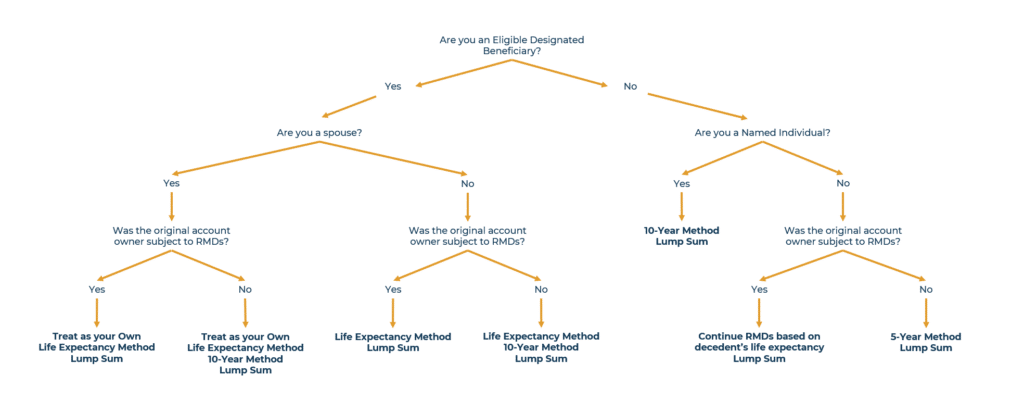Introduction
If you inherited all or part of an individual retirement account (IRA) or a qualified retirement plan, you may be wondering what you should do with the assets or the account. But the first question might be, what can you do. The rules governing inherited IRAs are complex – all the more so since the passage of the SECURE Act of 2019. The options available to you will depend on several factors, including the type of account you inherited, when you inherited it, your relationship to the deceased, and at what age the death occurred.
In the following paper, I discuss several factors that will determine what you can do with inherited retirement assets. These new inherited IRA rules can certainly get complicated, and therefore it is best to speak with your financial advisor or accountant to determine which of your available options makes the most sense for you.
Note: Unless otherwise specifically stated, this article applies to beneficiaries of account owners who passed away on or after January 1, 2020. If you inherited an IRA from an account owner who passed away in 2019 or before, please reference the article What to Do if you Inherit an IRA in 2019 or before.
Definitions of Key Terms
Required minimum distributions (RMDs) – Withdrawals that the IRS requires you to take each year from some tax-deferred accounts. RMDs are based on the value of an account on December 31st of the prior year and a life expectancy factor that is based on IRS Life Expectancy tables. Following the SECURE Act, an original account owner of a Traditional IRA is considered subject to RMDs if they were age 72 or older at the time of death or would have turned 72 in the year of death.
Required beginning date (RBD) – The date by which a person is required to start taking RMDs from their own IRA. For inherited accounts, the RBD will depend on the rollover strategy, your relationship to the original account owner, and the age at which death occurred.
5-year rule – Five tax years must pass after the first contribution to a Roth IRA before the first distribution of earnings can be made without tax implications.
Beneficiary classifications – These categories are a key determinant of what options are available to you when you inherit an IRA:
- Eligible designated beneficiaries (EDBs)
- Surviving spouse
- Disabled or chronically ill individual
- An individual that is not more than 10 years younger than the IRA owner
- Minor children
- Certain trusts
- Non-eligible designated beneficiaries (a.k.a. Designated Beneficiaries)
- An individual that doesn’t meet the requirements for an eligible designated beneficiary (e.g., an adult child)
- Certain trusts
- Non-designated beneficiaries
- Charities
- Estates
- Certain Trusts
Distribution Methods:
- Lump-sum method – The beneficiary withdraws the entire balance of the account at once. Depending on the original retirement account type, the withdrawal may be subject to income taxes. If the sum withdrawn is large enough, it may even push you into a higher marginal tax bracket, which would apply to the withdrawal. For Roth IRAs, a lump-sum withdrawal will be tax-free so long as the 5-year rule has been met. In addition to the tax implications, a major consideration to withdrawing a lump-sum is that, if the account is invested (which most are), you are eliminating the possibility for future investment growth. All beneficiaries have the option to use the lump-sum method of distribution.
- 5-year method – The beneficiary of an inherited IRA must distribute the entire balance of the account within five years of the death of the original owner. (Not to be confused with the 5-year rule, which governs taxation and requires a delay of five years after the first contribution to a Roth IRA before the first distribution of earnings can be made without penalty.)
- 10-year method – Introduced by the SECURE Act of 2019, this option requires the beneficiary of an inherited IRA to distribute the entire balance of the account within 10 years of the death of the original owner. There has been quite a bit of confusion over whether RMDs would be required in years 1-9. At present, Notice 2022-53 suggests that if the original account owner was subject to RMDs at their passing (i.e., over age 72), then the beneficiary would have to continue those RMDs in years 1-9 and then ensure the account balance is fully distributed by the end of year 10. An important note here is that if you inherited an IRA and did not make distributions in 2021 or 2022, you will not be penalized.
- Life expectancy method – The beneficiary of an inherited IRA must take RMDs each year. The life expectancy factor used to determine RMDs depends on your relationship with the original account owner and the age at death. This distribution method is an option for most IRA beneficiaries, but not all.
Stretch IRA Strategy – A non-spouse beneficiary of an IRA withdraws only the RMD amount each year from an inherited IRA. This strategy would allow the IRA to continue growing and the beneficiary to take full advantage of tax deferral.
 The SECURE Act
The SECURE Act
The SECURE Act of 2019 made the options and requirements for inherited retirement accounts significantly more complicated. Among the changes, it allowed for a new option for distributing account assets, defined a third category of beneficiaries, and increased the age at which RMDs are required to begin. It also eliminated the Stretch IRA for non-EDBs and non-designated beneficiaries.
Before the SECURE Act, an IRA owner generally needed to start taking RMDs by April 1st following the calendar year in which they reached age 70½. But by changing the RMD age to 72, the SECURE Act effectively changed this RBD. For those who turned 70½ in 2019, the RBD is still April 1, 2020, but those who turn age 70½ in 2020 or later can wait until April 1st of the year following their 72nd birthday.
Most designated beneficiaries (Non-EDBs) who inherit an IRA on or after January 1, 2020, may no longer use the Stretch IRA strategy. The change applies to Roth IRAs as well as pre-tax IRAs. Although the tax implications for Roth IRAs are negligible (since distributions from a Roth are tax free), the change still forces tax-free dollars out of the inherited Roth IRA sooner than previously required, reducing the ability to let the dollars grow tax-free for longer than 10 years.
Ownership/Distribution Options
All beneficiaries have the option to use the lump sum method. The following details the additional options available for each type of beneficiary.
1. Spouse
Spousal eligible designated beneficiaries have multiple options in addition to taking a lump sum.
- Option 1: Treat as your own
- If you are the primary beneficiary of your spouse’s retirement assets, you can generally treat inherited assets as if they are your own. Only in the case of pre-tax Traditional IRAs, if the decedent-spouse was subject to RMDs at the time of their passing, an RMD is required in the year of death if your spouse did not already take it prior to passing away. Otherwise, you can wait until your RBD to begin RMDs.
- NOTE: If you are not the sole listed beneficiary of your spouse’s retirement account, please refer to section V, MULTIPLE BENEFICIARIES OF INHERITED ASSETS MUST ACT INDEPENDENTLY.
- Treating the IRA as your own is generally the advised option for most spouses. However, if you are under age 59½ and need distributions from the account, you might be better off opening an inherited IRA and taking distributions using either the life expectancy, 10-year, or lump sum method because distributions from your own IRA prior to your age 59½ are subject to a 10% penalty.
- For Roth IRAs, as long as your account qualifies under the 5-year rule, you may be able to avoid taxation on withdrawals of earnings. Contributions in Roth IRAs are always available to be withdrawn tax-free.
- Option 2: The 10-Year method
- If your spouse was not subject to RMDs at the time of their passing, an alternative to treating the inherited account as your own is that you can open and transfer the assets into an inherited IRA and distribute the assets using the 10-year method. The 10-year method is not available if you inherit a pre-tax Traditional IRA and your spouse was subject to RMDs at the time of their passing. Note that this option is available for inherited Roth IRAs regardless of age.
- As described in the Terminology section, annual RMDs may be required in years 1-9, but we are waiting on clarified legislation. Regardless, the account will have to be fully distributed at the end of year 10.
- Option 3: The life expectancy method
- Under the life expectancy method, if you inherit a pre-tax Traditional IRA or a Roth IRA from your spouse, you have the option to open an inherited IRA and use the life expectancy method for distributions. In the case of an inherited Roth IRA and with a pre-tax Traditional IRA (if your spouse was not subject to RMDs at the time of their passing), you have the option to postpone RMDs until the later of when your spouse would have turned age 72 or until December 31st of the year following the year of death. These RMDs would be based on your single life expectancy.
- If your spouse was subject to RMDs and you choose the life expectancy method, there is no option to postpone your own RMDs. These must begin by December 31st of the year following the death, and these are based on either your single life expectancy or your spouse’s remaining single life expectancy, whichever is longer. If your spouse did not take their RMD in the year of their passing, you will have to take it before year-end.
2. Non-spouse eligible designated beneficiaries (Non-spouse EDBs)
Non-spouse EDBs have two options in addition to taking a lump sum.
- Option 1: The 10-year method
- A non-spouse EDB may transfer their inherited assets into an inherited IRA under their name. With the 10-year method, RMDs are not required in years 1-9 (although distributions are allowed during this time), and the account must be fully distributed by December 31st of the tenth year after the original account holder died.
- The 10-year method is not available to EDBs of pre-tax Traditional IRAs if the original account owner was subject to RMDs at the time of their passing. In this case, the life expectancy method or lump sum are the alternative options. The 10-year method is still available for inherited Roth IRAs.
- Option 2: The life expectancy method
- Under the life expectancy method, if you inherit a Roth IRA or pre-tax Traditional IRA (and the original account owner was not subject to RMDs), you have the option to open an inherited IRA and use the life expectancy method for distributions. In this case, RMDs must begin no later than December 31st the year following the year of death, and these will be based on your single life expectancy.
- If you inherit a pre-tax Traditional IRA and the original account owner was subject to RMDs you will have to take an RMD in the year of passing if the original account owner did not take it, in addition to annual RMDs beginning no later than the year following the year of death. The annual RMDs after the year of death will be based on either your single life expectancy or the original account owner’s remaining life expectancy, whichever is longer.
- One EDB with a notable exception here is minor children. Minor children may use the life expectancy method only until they reach the age of majority (usually age 18 or 21, depending on the state in which the child lives), at which point they must switch to the 10-year method.
- Should you use the life expectancy or 10-year method?
- If the original account owner was subject to RMDs, the 10-year method is not an option. However, if you are eligible, the answer to whether it’s more beneficial to choose the 10-year method or the life expectancy method depends on the value of the inherited account, your age, cash flow needs, your current tax situation, and your future income.
- If you inherit a pre-tax Traditional IRA and you are in a significantly higher tax bracket compared to where you’ll be in 10 years, the 10-year method may make the most sense. However, careful consideration should be taken in estimating your future tax bracket. A lot could happen in 10 years – You could choose to keep working and therefore still have taxable earned income similar to or greater than what you’re earning now; Tax laws could change; The account could grow significantly more than you anticipated, making the payout in year 10 much larger than you expected; This could impact your Medicare premiums, etc.
- Most likely it makes sense to use the life expectancy method for pre-tax Traditional inherited IRAs. The dollars in the inherited IRA (other than any annual RMD amounts) stay invested for your lifetime and the tax implications are spread throughout your lifetime versus a big tax hit in one year.
- If you inherit a Roth IRA, your tax and future income situation matters less, as Roth IRA distributions come out tax-free. Most likely, in the case of inherited Roth IRAs, it makes sense to use the life expectancy method. You will have to take RMDs each year, but depending on your age, this is likely going to be a very small portion of the account. Therefore, you are able to leave the majority of the account invested longer, versus having to fully distribute the account within 10 years.
- If you miss an RMD in any year within the first 10 years of the original account owner’s death you may be forced to use the 10-year method or pay a 50% tax penalty on the missed RMD amount.
- It’s best to consult your financial advisor and tax professional to determine which of these options would make more sense for your situation.
3. Non-eligible designated beneficiaries (a.k.a. Designated Beneficiaries)
The most common example of a Designated Beneficiary is an adult child. Designated beneficiaries only have one option in addition to the lump sum, which is the 10-year method.
For the 10-year option for designated beneficiaries, RMDs may be required in years 1-9, but we are waiting on clarified legislation. Regardless, the account will have to be fully distributed at the end of year 10. For a pre-tax Traditional inherited IRA, if the original account owner was subject to RMDs at the time of their passing, an RMD would be required in the year of death if the original account owner did not take it prior to their passing.
4. Non-designated beneficiaries
If the original account owner was subject to RMDs at the time of their passing, non-designated beneficiaries must continue RMDs using the original account owner’s single life expectancy.
If the original account owner was not subject to RMDs at the time of their passing, the 5-year method applies. The 5-year method is similar to the 10-year method, except the account must be fully distributed by the end of the fifth year following the year of death.
Converting a Pre-Tax Retirement Account to an Inherited Roth IRA
For a non-spouse designated beneficiary of an employer-sponsored retirement plan (like a 401k), you have the option to roll over your inherited assets into an inherited Roth IRA. In this case, the entire account balance would be added to your taxable income in the year of transfer, and you would be subject to the 10-year method for distributions. However, those distributions from the inherited Roth IRA would not be taxed again after the year of the initial rollover.
It’s important to differentiate the rules for an inherited pre-tax Traditional IRA, as a non-spouse designated beneficiary is NOT allowed to convert an inherited Traditional IRA into an inherited Roth IRA.
As a spouse beneficiary, you have the option to treat the inherited assets as your own. Therefore, after you rollover your late-spouse’s assets into your own retirement account, you have the option to convert to a Roth IRA, pay taxes in the year of transfer, and then benefit from tax-free distributions going forward (so long as you have met the 5-year rule).
Multiple Beneficiaries of Inherited Assets Must Act Independently
When a retirement account contains multiple beneficiaries, the IRA must be divided into separate accounts for each beneficiary by September 30 of the calendar year following the calendar year of the original account owner’s death. This is a very important note (especially for surviving spouses, whose options are much more flexible, including the ability to treat the IRA as your own).
If the IRA is not split by September 30, and all beneficiaries are individuals, then the beneficiary with the shortest life expectancy will be considered the designated beneficiary for purposes of calculating any RMD amounts and for determining whether they are an eligible designated beneficiary. If the designated beneficiary is an eligible designated beneficiary, then RMDs are calculated using the Life Expectancy Method according to the oldest beneficiary’s life expectancy factor.
Distributions to a non-EDB must follow the 10-year Method.
Carefully Consider Your Options
This paper is intended to provide a broad overview of the various options available to those who inherit a retirement account with considerable assets. Each option is governed by a detailed set of rules and entails caveats that can make the decision extremely complicated. In addition, it’s important for beneficiaries to take into account the tax implications to avoid paying more taxes than needed (or even penalties). For that reason, it is recommended that you review all your options with a trusted financial advisor or accountant who understands your financial situation and has expertise and experience helping individuals manage financial inheritances.
Sources:

 The SECURE Act
The SECURE Act


